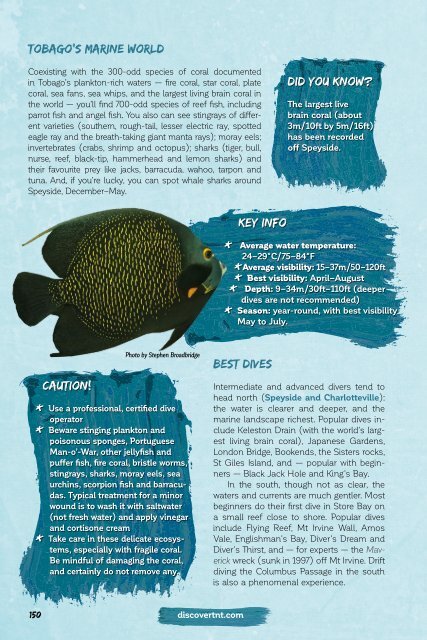Discover Trinidad & Tobago 2016 — 25th Anniversary Edition
With our 2016 edition (our 27th), we celebrate 25 years of producing Discover Trinidad & Tobago. Published every year since 1991, Discover Trinidad & Tobago is aimed both at international visitors planning a trip to the islands – whether for an eco adventure, business trip, or beach holiday – and at local Trinbagonians looking to know and explore more about their native islands. Our comprehensive coverage of Trinidad and Tobago — from arts and culture to eco adventures, accommodation to sports, planning flights and transportation and more — can help anyone plan anything from a day trip or weekend escape, to a full-on an adventure holiday or leisurely vacation. It might take a lifetime to truly experience all that the islands have to offer, but at least we can show you where to start. For more: http://www.discovertnt.com • http://www.facebook.com/discovertnt
With our 2016 edition (our 27th), we celebrate 25 years of producing Discover Trinidad & Tobago. Published every year since 1991, Discover Trinidad & Tobago is aimed both at international visitors planning a trip to the islands – whether for an eco adventure, business trip, or beach holiday – and at local Trinbagonians looking to know and explore more about their native islands. Our comprehensive coverage of Trinidad and Tobago — from arts and culture to eco adventures, accommodation to sports, planning flights and transportation and more — can help anyone plan anything from a day trip or weekend escape, to a full-on an adventure holiday or leisurely vacation. It might take a lifetime to truly experience all that the islands have to offer, but at least we can show you where to start. For more: http://www.discovertnt.com • http://www.facebook.com/discovertnt
You also want an ePaper? Increase the reach of your titles
YUMPU automatically turns print PDFs into web optimized ePapers that Google loves.
<strong>Tobago</strong>’s marine world<br />
Coexisting with the 300-odd species of coral documented<br />
in <strong>Tobago</strong>’s plankton-rich waters <strong>—</strong> fire coral, star coral, plate<br />
coral, sea fans, sea whips, and the largest living brain coral in<br />
the world <strong>—</strong> you’ll find 700-odd species of reef fish, including<br />
parrot fish and angel fish. You also can see stingrays of different<br />
varieties (southern, rough-tail, lesser electric ray, spotted<br />
eagle ray and the breath-taking giant manta rays); moray eels;<br />
invertebrates (crabs, shrimp and octopus); sharks (tiger, bull,<br />
nurse, reef, black-tip, hammerhead and lemon sharks) and<br />
their favourite prey like jacks, barracuda, wahoo, tarpon and<br />
tuna. And, if you’re lucky, you can spot whale sharks around<br />
Speyside, December–May.<br />
Did you know?<br />
The largest live<br />
brain coral (about<br />
3m/10ft by 5m/16ft)<br />
has been recorded<br />
off Speyside.<br />
Key info<br />
Average water temperature:<br />
24–29°C/75–84°F<br />
Average visibility: 15–37m/50–120ft<br />
Best visibility: April–August<br />
Depth: 9–34m/30ft–110ft (deeper<br />
dives are not recommended)<br />
Season: year-round, with best visibility<br />
May to July.<br />
t h e<br />
Caution!<br />
Photo by Stephen Broadbridge<br />
Use a professional, certified dive<br />
operator<br />
Beware stinging plankton and<br />
poisonous sponges, Portuguese<br />
Man-o’-War, other jellyfish and<br />
puffer fish, fire coral, bristle worms,<br />
stingrays, sharks, moray eels, sea<br />
urchins, scorpion fish and barracudas.<br />
Typical treatment for a minor<br />
wound is to wash it with saltwater<br />
(not fresh water) and apply vinegar<br />
and cortisone cream<br />
Take care in these delicate ecosystems,<br />
especially with fragile coral.<br />
Be mindful of damaging the coral,<br />
and certainly do not remove any.<br />
best dives<br />
Intermediate and advanced divers tend to<br />
head north (Speyside and Charlotteville):<br />
the water is clearer and deeper, and the<br />
marine landscape richest. Popular dives include<br />
Keleston Drain (with the world’s largest<br />
living brain coral), Japanese Gardens,<br />
London Bridge, Bookends, the Sisters rocks,<br />
St Giles Island, and <strong>—</strong> popular with beginners<br />
<strong>—</strong> Black Jack Hole and King’s Bay.<br />
In the south, though not as clear, the<br />
waters and currents are much gentler. Most<br />
beginners do their first dive in Store Bay on<br />
a small reef close to shore. Popular dives<br />
include Flying Reef, Mt Irvine Wall, Arnos<br />
Vale, Englishman’s Bay, Diver’s Dream and<br />
Diver’s Thirst, and <strong>—</strong> for experts <strong>—</strong> the Maverick<br />
wreck (sunk in 1997) off Mt Irvine. Drift<br />
diving the Columbus Passage in the south<br />
is also a phenomenal experience.<br />
150<br />
discovertnt.com


















